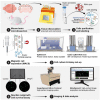Novel adult cortical neuron processing and screening method illustrates sex- and age-dependent effects of pharmaceutical compounds
- PMID: 35908049
- PMCID: PMC9338961
- DOI: 10.1038/s41598-022-17389-4
Novel adult cortical neuron processing and screening method illustrates sex- and age-dependent effects of pharmaceutical compounds
Abstract
Neurodegenerative diseases and neurotraumatic injuries are typically age-associated disorders that can reduce neuron survival, neurite outgrowth, and synaptic plasticity leading to loss of cognitive capacity, executive function, and motor control. In pursuit of reducing the loss of said neurological functions, novel compounds are sought that promote neuron viability, neuritogenesis, and/or synaptic plasticity. Current high content in vitro screenings typically use cells that are iPSC-derived, embryonic, or originate from post-natal tissues; however, most patients suffering from neurodegenerative diseases and neurotrauma are of middle-age and older. The chasm in maturity between the neurons used in drug screens and those in a target population is a barrier for translational success of in vitro results. It has been historically challenging to culture adult neurons let alone conduct screenings; therefore, age-appropriate drug screenings have previously not been plausible. We have modified Miltenyi's protocol to increase neuronal yield, neuron purity, and neural viability at a reduced cost to expand our capacity to screen compounds directly in primary adult neurons. To our knowledge, we developed the first morphology-based screening system using adult cortical neurons and the first to incorporate age and sex as biological variables in a screen using adult cortical neurons. By using primary adult cortical neurons from mice that were 4 to 48 weeks old for screening pharmaceutical agents, we have demonstrated age- and sex-dependent effects on neuritogenesis and neuron survival in vitro. Utilizing age- and sex-appropriate in vitro models to find novel compounds increasing neuron survival and neurite outgrowth, made possible by our modified adult neuron processing method, will greatly increase the relevance of in vitro screening for finding neuroprotective compounds.
© 2022. The Author(s).
Conflict of interest statement
The authors declare that the research was conducted in the absence of any commercial or financial relationships that could be construed as a potential conflict of interest. A.S. and C.G.G. currently hold pending patent applications regarding the technology listed herein and are substantial owners of NeuroCreis.
Figures








Similar articles
-
Neuronal Exosomes Secreted under Oxygen-Glucose Deprivation/Reperfusion Presenting Differentially Expressed miRNAs and Affecting Neuronal Survival and Neurite Outgrowth.Neuromolecular Med. 2021 Sep;23(3):404-415. doi: 10.1007/s12017-020-08641-z. Epub 2021 Jan 3. Neuromolecular Med. 2021. PMID: 33389598
-
High content screen microscopy analysis of A beta 1-42-induced neurite outgrowth reduction in rat primary cortical neurons: neuroprotective effects of alpha 7 neuronal nicotinic acetylcholine receptor ligands.Brain Res. 2007 Jun 2;1151:227-35. doi: 10.1016/j.brainres.2007.03.051. Epub 2007 Mar 24. Brain Res. 2007. PMID: 17449017
-
Rosuvastatin improves neurite extension in cortical neurons through the Notch 1/BDNF pathway.Neurol Res. 2019 Jul;41(7):658-664. doi: 10.1080/01616412.2019.1610226. Epub 2019 Apr 25. Neurol Res. 2019. PMID: 31023175
-
Cocaine- and amphetamine-regulated transcript facilitates the neurite outgrowth in cortical neurons after oxygen and glucose deprivation through PTN-dependent pathway.Neuroscience. 2014 Sep 26;277:103-10. doi: 10.1016/j.neuroscience.2014.06.064. Epub 2014 Jul 8. Neuroscience. 2014. PMID: 25010400
-
Serotonin regulation of neurite outgrowth in identified neurons from mature and embryonic Helisoma trivolvis.Perspect Dev Neurobiol. 1998;5(4):373-87. Perspect Dev Neurobiol. 1998. PMID: 10533526 Review.
Cited by
-
Neurotoxic properties of the Zika virus envelope protein.Exp Neurol. 2023 Sep;367:114469. doi: 10.1016/j.expneurol.2023.114469. Epub 2023 Jun 14. Exp Neurol. 2023. PMID: 37327963 Free PMC article.
-
New approach methodologies to address population variability and susceptibility.Hum Genomics. 2023 Jun 28;17(1):56. doi: 10.1186/s40246-023-00502-7. Hum Genomics. 2023. PMID: 37381067 Free PMC article. No abstract available.
-
Selective, Intrinsically Fluorescent Trk Modulating Probes.ACS Chem Neurosci. 2024 Oct 2;15(20):3679-91. doi: 10.1021/acschemneuro.4c00290. Online ahead of print. ACS Chem Neurosci. 2024. PMID: 39356215 Free PMC article.
-
Aryl hydrocarbon receptor restricts axon regeneration of DRG neurons in response to injury.bioRxiv [Preprint]. 2024 Sep 14:2023.11.04.565649. doi: 10.1101/2023.11.04.565649. bioRxiv. 2024. PMID: 37961567 Free PMC article. Preprint.
-
Isolation of Primary Brain Cells: Challenges and Solutions.Arch Clin Biomed Res. 2025;9(4):286-296. doi: 10.26502/acbr.50170464. Epub 2025 Jul 14. Arch Clin Biomed Res. 2025. PMID: 40761884 Free PMC article.
References
-
- Statista. (Statista, statista.com, 2021).
-
- Centers for Disease Control and Prevention. Rates of TBI-related Hospitalizations by Age Group—United States, 2001–2010, https://www.cdc.gov/traumaticbraininjury/data/rates_hosp_byage.html Accessed 21 July 2022 (2016).
Publication types
MeSH terms
Substances
Grants and funding
LinkOut - more resources
Full Text Sources
Other Literature Sources

